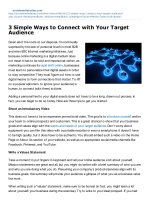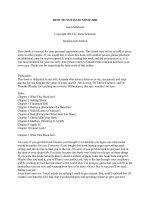baby signs how to talk with your baby
Bạn đang xem bản rút gọn của tài liệu. Xem và tải ngay bản đầy đủ của tài liệu tại đây (16.48 MB, 208 trang )
What Parents and Grandparents Are Saying About Baby Signs . . .
is book changed our lives.
I cannot emphasize enough how valuable this book is. It was so wonderful to be able to
communicate clearly and specically with our daughter in the months before her now
incredible verbal abilities blossomed forth. Baby Signs truly provides a window into your
baby’s mind. I urge all parents of young babies to put these signs to work for you.
—A reader from Northern California
A must-read for every parent who cares!
We have used this book with both of our sons. Our oldest (now three) has a larger
vocabulary than most ve-year-olds. Even our pediatrician commented on his vocabulary
skills. But all of this is secondary to just being able to meet the needs of our kids. We know
if they are hungry, tired, thirsty, or need a diaper change.
—A reader from Cincinnati, Ohio
e most rewarding experience of parenting!
Communicating with your baby or toddler before he or she can speak is so amazing!
My rst child learned over fty signs by age fteen months. This is a very easy book to read;
it has excellent sign suggestions and illustrations in the back of the book.
—A reader from Chicago, Illinois
is is a very important childcare book!
I’m a language development specialist and an English teacher, and I love to see the way
this method encourages the formation of language concepts in my baby’s mind. She’s been
“saying” three-word sentences since thirteen months, and the level of bonding and reduction
of what-does-that-baby-need stress has been remarkable.
—A reader from Central California
Best investment for you and your child!
There is no end to my amazement at how much this little guy of mine is capable of.
This book is an incredible tool for any parent interested in opening the lines of
communication with her baby.
—A reader from Holland, Michigan
A great concept, simply presented!
This book was one of the greatest things to happen to me as a parent. Using Baby Signs is
amazing. I gained so much respect for my son and had such a great time using Baby Signs
with him. He could express his needs, his desires, his ideas, and even make a few jokes and
puns. Now my son is two and a half, and he constantly amazes people because he can speak
and think like a four- or ve-year-old. I credit Baby Signs.
—A reader from Dallas, Texas
I can talk to my baby before my baby can talk!
I originally had this book with my now ve-year-old. By the time he talked, he was using
over forty practical signs. He was talking in sentences by age two. I have a fourteen-month-
old son who also uses many signs—and makes up his own! It is so wonderful to be able to
communicate with my baby. He tells me what he sees, hears, wants, and how he feels—at
fourteen months old!
—A reader from California
Delivers what it promises!
I started using the signs with my daughter when she was eight months. When she was ten
months, she suddenly started signing. They were right about babies talking sooner and better
with signing. My daughter would combine signs and words by the time she was one year old
and talked in sentences by the time she was two.
—A reader from Poplar Bluff, Missouri
Must-have for parents!
I cannot say enough about this book and all that it has added to our relationship with our
little ones. Both of my children, now two and four, are very verbal and have been able to
express themselves from very early on. This book is well worth the investment—being able to
meet their needs and communicate with our children is priceless!
—A reader from Naperville, Illinois
It works, it works, it works!
I bought this when my baby was just a couple of months old. We started signing a few things
at six months. My son can tell me when he wants a drink, and when he wants a snack, etc.
I love this! Try it. It takes consistency, but it is worth it!
—A reader from Eastern Iowa
e best thing I’ve done for my child!
I think signing with my baby is the single most important thing I have done to enhance
her development and our relationship. Baby Signs has enriched our lives in so many
amazing ways!
—A reader from Dallas, Texas
Forgo the frustration!
Baby Signs is a wonderful book! My daughter began doing the signs at eight months and
by thirteen months knew about forty! We did not have the frustration in communicating the
way our friends seemed to. I had so much fun with my daughter that I also used it for my son
with great success. A really fun resource!
—A reader from Wisconsin
Required reading for every parent and grandparent!
This book should be given to every parent before they can leave the hospital. The deceptively
simple approach to nonverbal communication with children in the nine- to twenty-four-month
range presented here is nothing short of magic! My grandchildren can tell us when they are
hungry or thirsty, the water is too hot or cold, and if they want more.
—A reader from Chicago, Illinois
BABY
SIGNS
How to Talk with Your Baby
Before Your Baby Can Talk
Linda Acredolo, Ph.D., and Susan Goodwyn, Ph.D.
New York Chicago San Francisco Lisbon London Madrid Mexico City
Milan New Delhi San Juan Seoul Singapore Sydney Toronto
BABY
SIGNS
How to Talk with Your Baby
Before Your Baby Can Talk
Linda Acredolo, Ph.D., and Susan Goodwyn, Ph.D.
New York Chicago San Francisco Lisbon London Madrid Mexico City
Milan New Delhi San Juan Seoul Singapore Sydney Toronto
Copyright © 2009 by Linda Acredolo and Susan Goodwyn. All rights reserved. Except as permitted under the United States Copyright Act
of 1976, no part of this publication may be reproduced or distributed in any form or by any means, or stored in a database or retrieval
system, without the prior written permission of the publisher.
ISBN: 978-0-07-161504-4
MHID: 0-07-161504-0
The material in this eBook also appears in the print version of this title: ISBN: 978-0-07-161503-7, MHID: 0-07-161503-2.
All trademarks are trademarks of their respective owners. Rather than put a trademark symbol after every occurrence of a trademarked name,
we use names in an editorial fashion only, and to the benefit of the trademark owner, with no intention of infringement of the trademark.
Where such designations appear in this book, they have been printed with initial caps.
McGraw-Hill eBooks are available at special quantity discounts to use as premiums and sales promotions, or for use in corporate training
programs. To contact a representative please visit the Contact Us page at www.mhprofessional.com.
TERMS OF USE
This is a copyrighted work and The McGraw-Hill Companies, Inc. (“McGraw-Hill”) and its licensors reserve all rights in and to the work.
Use of this work is subject to these terms. Except as permitted under the Copyright Act of 1976 and the right to store and retrieve one copy
of the work, you may not decompile, disassemble, reverse engineer, reproduce, modify, create derivative works based upon, transmit, distrib-
ute, disseminate, sell, publish or sublicense the work or any part of it without McGraw-Hill’s prior co sent. You may use the work for your
own noncommercial and personal use; any other use of the work is strictly prohibited. Your right to use the work may be terminated if you
fail to comply with these terms.
THE WORK IS PROVIDED “AS IS.” McGRAW-HILL AND ITS LICENSORS MAKE NO GUARANTEES OR WARRANTIES AS TO
THE ACCURACY, ADEQUACY OR COMPLETENESS OF OR RESULTS TO BE OBTAINED FROM USING THE WORK,
INCLUDING ANY INFORMATION THAT CAN BE ACCESSED THROUGH THE WORK VIA HYPERLINK OR OTHERWISE, AND
EXPRESSLY DISCLAIM ANY WARRANTY, EXPRESS OR IMPLIED, INCLUDING BUT NOT LIMITED TO IMPLIED
WARRANTIES OF MERCHANTABILITY OR FITNESS FOR A PARTICULAR PURPOSE. McGraw-Hill and its licensors do not warrant
or guarantee that the functions contained in the work will meet your requirements or that its operation will be uninterrupted or error free.
Neither McGraw-Hill nor its licensors shall be liable to you or anyone else for any inaccuracy, error or omission, regardless of cause, in the
work or for any damages resulting therefrom. McGraw-Hill has no responsibility for the content of any information accessed through the
work. Under no circumstances shall McGraw-Hill and/or its licensors be liable for any indirect, incidental, special, punitive, consequential
or similar damages that result from the use of or inability to use the work, even if any of them has been advised of the possibility of such
damages. This limitation of liability shall apply to any claim or cause whatsoever whether such claim or cause arises in contract, tort or
otherwise.
Disclaimer:
This eBook does not include the ancillary media that was
packaged with the original printed version of the book.
Contents | vii
Foreword: Robin Hansen, M.D., FAAP xi
Preface xiii
1 Introducing the Baby Signs Program 1
Is the Baby Signs Program Good for Babies? 3
BenetsforYouandYourBaby5
As Easy as Waving Bye-Bye 13
2 The Baby Signs Program: Right for Every Family 15
The Baby Signs All-ASL Program 16
The Baby Signs “Baby-Friendly” Program 22
MoreAboutBabyCreations28
A Program for Everyone 29
3 Start Signing with Your Baby! 31
When to Start Signing 31
IsYourBabyReadyforSigns?32
HowtoGetStarted:TenTipsforSuccess37
Contents
viii | Baby Signs
Contents | ix
YourBaby’sProgress43
DifferencesAmongBabies46
EnrichYourBaby’sSigningExperience50
KeepingYourEyeontheRightPrize55
4 Signs, Signs, and More Signs 57
Mealtime59
Bathtime 61
Bedtime 63
GettingDressed65
AtthePark67
Animals and Pets 69
ChoosingSignstoTeach73
5 Off and Running with Signs 75
Here,There,andEverywhere76
FeelingsDiscovered77
FirstMetaphors80
SignSentences82
PottyTrainingwiththeBabySignsProgram84
Off andRunning—inDifferentDirections91
6 From Signs to Speech 93
ADressRehearsalforTalking94
WhyYourBabyWantstoTalk96
TheTransitiontoSpeech99
GonebutNotForgotten100
ALegacyof LoveThatLastsaLifetime103
viii | Baby Signs
Contents | ix
Appendix A: Signing and Childcare: 105
A Wonderful Partnership
Appendix B: Further Research and Readings 113
Appendix C: Baby Signs Dictionary 123
Appendix D: Baby Signs Resources 181
This page intentionally left blank
Foreword | xi
Foreword
ASAPEDIATRICIAN,IFREQUENTLYHEARFROMPARENTSWHOSE
sweet,easy-goingnine-month-oldhassuddenlyturnedintoademandingand
easilyfrustratedtwelve-toeighteen-month-old.Weusedtoblamethistransfor-
mationvaguelyonthe“terribletwos”(despitethefactthatit’sthehighlyunusual
childwhowaitsuntilagetwo).Muchof thetantrumingweseeinthesecond
yearresultsdirectlyorindirectlyfromchildrennotbeingabletocommunicate.
Justasistrueforallof us,notbeingabletoletpeopleknowwhattheyneed,
feel,orthinkaboutleaveschildrenextremelyfrustrated. Unlikeus,however,
theyareleftwithfewalternativesbuttoscreamlouderandcryharder.
Nowparentsdon’tneedtosimplyendurethisdifculttime.ThankstoBaby
Signs,andthe twodecades of carefullyconductedresearch upon whichit is
based,parentsnallyhaveawonderfultooltohelptheirchildrenwhowantso
badlytocommunicatebutwhosevocalskillshavenotdevelopedenoughtodo
so.Likeanincreasingnumberof pediatriciansaroundthecountry,Istrongly
encourageparentstousetheBabySignsprogram.Justaswehavelearnedthat
nursingisimportantfornurturingyourbaby’sbody,wenowknowthatsign-
ingisimportantfornurturingyourbaby’smindandheart.
Asaclinicianandaresearcher,Ihavebeenparticularlyimpressedwiththe
systematic way the authorshave studied theeffects of signingon children’s
development. Their scientic research, fundedby the National Institutes of
Health, has demonstrated that byusing signs, babies can communicate their
needs and desires months before most babies otherwise can do so verbally.
xii | Baby Signs
Inaddition,theBabySignsprogramhelpsbabieslearntotalksooner.Italso
booststheirself-esteemandallowsthemtodeveloptheiremotionalawareness.
Beyondthedevelopmentalbenetstothebaby,parentsreporthowmuchfun
they have with their baby and how thrilling it is to explore the world together
usingsigns.
Whetheryouwanttohelpyourchildexpressherneedsbeforeshecantalk,
helpherconveyheremotions,orhelpherboostherintellectualdevelopment,
theBabySignsprogramisoneof thebestthingsyoucandoforyourbaby.
That’swhyIrecommendBaby SignstonewparentsandwhyIenthusiastically
recommendittoyou.
—RobinHansen,M.D.,FAAP
Dr. Hansen is a pediatrician and chief of Developmental-Behavioral Pediatrics at
the University of California School of Medicine. She is also co-chair of the Education
Committee for the Society of Developmental Behavioral Pediatrics and a member of the
American Academy of Pediatrics Section of Developmental Behavioral Pediatrics.
Preface | xiii
xii | Baby Signs
Preface | xiii
OVERTHEPASTTWODECADESWEHAVEINTRODUCEDHUNDREDS
of thousandsof parents,teachers,andpediatricianstotheadvantagesof the
BabySignsprogram.Invariably,theresponsehasbeenamazementatthesim-
plicity of the program and enthusiasm about themany benets signingcan
bringtobabiesandtheirfamilies.Evenourmostvocalskepticshavebeenwon
overafterseeingababysigning—purposefullycommunicatingtohismomthat
hewantsacracker,needsmorejuice,isfeelingtoohot,orseesabirdupinthe
tree.Itisamazingwhatlittlehandsandmindscandoif giventhetools(signs)
theyneedto“tell”uswhattheyknow.Butwheredidourownenthusiasmcome
from?Whoconvincedusthatsignswereindeedsomethingspecial?
How the Baby Signs Program Began
It started on a summer day in 1982 when Linda and her twelve-month-old
daughter,Kate,wereoutinthegarden.Enchantedbythecolorfulbloomsall
aroundher,Katepointed to a rose bush, wrinkled uphernose,and sniffed
repeatedly.Lifewithchildrenoftenslowsparentsdownlongenoughto“smell
theroses,”andLindahadoftenpickedthemforKatetosmell,allthewhile
sayingthingslike“Seetheower,Kate!Seetheprettyower!”Clearly,Kate
rememberedthe connection betweenthe snifng action and the object, and
shetrustedthattheadultsaroundherwould,too.Fortherestof thedayKate
continuedwrinklinghernoseandsnifng,whichwashersignforallkindsof
Preface
xiv | Baby Signs
Preface | xv
owers—inthehouse,onherclothes,andinpicturesinherbooks.Katecon-
tinuedtoborroworcreatesignsforotherthingsshewantedtotalkabout,such
assh,elephants,monkeys,swings,slides,andballs.Itwasn’tuntiltwoweeks
laterthatwerealizedthesignicanceofwhatKatewasdoing.
Out of Our Living Room, into Our Laboratory
Aschilddevelopmentresearchers,wewereeagertoseewhetherotherinfants
wereusingsigns,too.Tondtheanswer,webegansystematicallyinterviewing
parentstondoutwhethertheirbabiesspontaneouslycreatedsigns,asKate
haddone.Within daysof starting our interviews, the answerwasclear.Not
onlydidmanyparentsgiveusexamplesof signstheirbabieswereusing,but
thebabiesthemselveswouldoccasionallyinterruptourvisitto“talk”toMom,
includingasignortwointheprocess.
Welearnedagreatdealfromthesefamilies.Andthemorewelearned,the
more convinced we became that babies are eager to communicate and that
theircreationof signsisanaturalpartof day-to-dayfamilylife.Manybabies
seemedtospontaneouslydevelopatleastafewsignsbeyondtheuniversalbye-
bye, yes, and no,usuallybetweennineandtwenty-fourmonthsof age.Wealso
noticedthatsomebabiestooktotheideawithenthusiasm,creatinganimpres-
sivevarietyof signsforfavoriteobjectsandimportantneeds.Invariably,these
babieshadfamilieswhosharedtheirenthusiasmandencouragedthesigning.
Moreover,ittendedtobethecasethatthemoresignsaninfantused,thefaster
thatchildlearnedtotalk.Thiswasourbestclueyetabouttheeffectof theBaby
Signsprogramonspokenlanguagedevelopment.Signingseemed,if anything,
tospeeduptheprocess.
Itwasatthispointthatweknewweneeded togure outa wayto help
babiesalong.Thus,webeganencouragingparentstopurposefullyteachtheir
babiesafewmoresignstohelpthemcommunicatetheirbasicneeds,feelings,
andinterests—anythingtheirbabieswantedorneededto“talk”about—until
theycouldtalkwellenoughtocommunicatewithwords.AndtheBabySigns
programwasborn!
xiv | Baby Signs
Preface | xv
The Original Baby Signs Program
The Baby Signs program began with baby-created signs—simple move-
mentsandgesturesthatbabiesthemselvestookfromtheirroutineexperiences
withthepeopleandthingsaroundthem.Drawingfromsongs,games,orplay-
fulinteractionswithtoysandotherobjects,babieswerendingwaysto“talk”
beforetheycouldtalk.Forexample,severalbabiesweobservedtwistedtheir
indexngertipstogethertolabelspiders—realspiders,picturesofspiders,and
evenplastictoyspiders.Whatthesebabieshadincommon,wediscovered,was
theexperience of learningthesong “Eensy-Weensy Spider” (alsoknownas
“Itsy-BitsySpider”),alongwiththehandgesturesthataccompanykeywords,
like spider, rain, and sun.Otherbabies,wefound,stucktheirtonguesoutand
“panted”tocalltheirparents’attentiontodogs—clearlyanimitationof what
theysawrealdogsdoing.Creationssuchasthesenotonlyprovidedindisputable
evidenceof howsmartbabiesare,theyalsoshowedjusthowstronglymoti-
vatedbabiesaretocommunicatewiththepeoplearoundthem.
Intheseearlyyears,beforesigningwithhearingbabieswasawell-accepted
practice,someparents werereluctantto trysigningbecause,as theytold us,
theirbabieswerenotdeaf.Atthattime,signingwasseenasameansof com-
municationonlyforpeoplewithhearingimpairments.Ontheotherhand,par-
entswereeagertotryusingsignsthatourresearchhadshowncamenaturally
forbabies.Soweprovidedparentswithfty“signsuggestions,”simplesigns
that we had seen babies in our research studies create. We also encouraged
parentstowatchfortheirownbaby’screationsandtocreatesignsthemselves
whentheneedarose.Thisrstapproachtohelpingparentsgetstartedwith
ourBabySignsprogrambecametheheartof thersteditionofthisBaby Signs
book.Publishedin1996,itlaunchedtheextraordinaryBabySignsmovement,
whichhasrevolutionizedthewaytoday’sparentscommunicatewiththeirbabies
beforetheirbabiescantalk.
xvi | Baby Signs
Preface | xvii
The Baby Signs Program Evolves
Assigningwithhearingbabiesbecamemorepopular,parentsbecameeagerto
teachtheirbabiesmoresigns.Asawaytoexpandtheirownsigningrepertoires,
someparentsturnedtoAmericanSignLanguage(ASL),theofciallanguage
of theDeaf community,withitsextensivevocabularyof establishedsigns.We
werethrilled tosee parents soexcitedabout enhancing theirsigning experi-
ences,and wecontinueto stronglysupportparents who wantto teachtheir
babiesthesignsof ASL.
Toembraceparents’enthusiasticresponsetosigning,werevisedtheBaby
Signsprogramtoincreasethenumberof signsuggestionsfromftytoone
hundred—about80percentof whichwereASLsigns,withtheother20percent
being either slightly modiedASL signsor alternative“baby-friendly”signs.
Thesecondeditionof thebookwaspublishedin2002tointroducethisnewly
expandedprogramtoparentsthroughouttheworld.
Signing with Hearing Babies: A Worldwide Movement
Littledidweknowin1982thattheBabySignsprogramwouldbecomeaworld-
widemovement.BabySignsworkshops,classes,andtrainingsarenowoffered
inoverfortycountries,andBabySignsbooksandproductshavebeentrans-
latedintoalmosttwentyforeignlanguages.Throughoutthisamazinggrowth,
ourmissionhasremainedthesame—tobringthebenetsof theBabySigns
programtoasmanyfamiliesaspossible.
To achieve our mission, we formedthe BabySigns Institute to continue
ourresearchonthewaysinwhichtheBabySignsprograminuenceschildren’s
developmentandtodesigncurriculaforsigningworkshopsandclasses.Wenow
offertheBabySignsParentWorkshoptointroduceparentstothebenetsof
signingwiththeirbabies;twosix-weeksessionsof Sign,Say&Playclassesto
giveparentsandbabiesfunandinteractivewaystolearnsignstogether;andan
earlychildhoodeducatortrainingtohelpchilddevelopmentcentersincorporate
theBabySignsprogramintotheirinfantandtoddlerclassrooms.
xvi | Baby Signs
Preface | xvii
We also founded Baby Signs, Inc., to create developmentally appropri-
atebooks,toys,musicCDs,and videos for childrenand educational signing
resourcesfor parents and caregivers. Alisting of these products,along with
detaileddescriptionsandpurchasinginformation,isincludedinAppendixD
of thisbook.
Weareespeciallyproudof our BabySignsDVDs.In moderateamounts
andwithdevelopmentallyappropriatecontent,videoscanbeapositivesource
of learningforyoungchildren.Ourstrategyindevelopingthesevideoswasto
keepthetimeshortandthecontenthighqualityandeducational—including
animatedandrealsigningchildrenfromwhombabiescanlearntosignthem-
selves. We havealso made sure that the audio and visual elements of these
DVDsarefun,engaging,and,mostofall,intunewithbabies’developingabili-
ties.Wehaveaccomplishedthisthroughtheuseof animation,delightfulpup-
pets,happybabies,andcarefulattentiontopacingandrepetition.
The Baby Signs Program: Right for Every Family
Somefamilies,wehavefound,wanttoteachtheirbabiesASLsignsonly.Other
familiespreferamoreexibleapproachandchoosetoincludeafewmodied
ASLsignstomakethemeasierfortheirbabies’littlehandstomaster.Andstill
otherfamiliesreallyvaluethefreedomtocreatesignsthatworkbestfortheir
ownbabies—signsthattheirbabiescaneasilydotocommunicateaboutthings
importantintheirownfamily’sdailyinteractions.Becausewelovehelpingall
familiesndthebestwaytostartsigningwiththeirbabies,wecontinuallyrevise
theBabySignsprograminordertomeetthesefamilies’variousneeds.
Ourmajorgoalforthisnewedition is to introduce our new BabySigns
program,whichoffersanall-ASL approachforthemanyfamilieswhowant
tointroducetheirchildtothisrichandvitallanguage.Atthesametime,italso
includesasetof baby-friendlyalternativesignsandstrategiesforfamilieswho
preferamoreexibleapproach.Inotherwords,theBabySignsprogramnow
xviii | Baby Signs
meetstheneedsof allfamilieswhowanttoquicklyandeasilybeginexperienc-
ingthejoysthatsigningwiththeirbabycanbring.
ThisneweditionhasalsoprovidedustheopportunitytoupdatetheBaby
Signsresearchsections,includingexcitingndingsregardingsigningandemo-
tional development and the impact of the Baby Signs program in childcare
centersandchildhoodenrichmentprograms.Infact,wehaveincludedanew
appendixthatdescribeswhatweknowaboutusingtheBabySignsprogramin
childdevelopmentcenters,thebenetsspecictothechildrenandteachersin
childcareprograms,andadviceforhelpingyourchild’scenterbecomeacerti-
edBabySignsCenter.
And,bestof all,thisneweditioncomeswithafreeofferforacopyof our
newest Baby Signs Video DictionaryDVD,a$19.99retailvalue.Thisinstructional
DVDincludesdemonstrationsof 150ASLsignsand35baby-friendlysigns,
eacheasilyaccessiblethroughjustatouchof yourremotecontrol.Detailsfor
gettingyourfreecopyareincludedinthebackof thebook,sobesuretotake
advantageof thissuperteachingaid.
Itgivesusgreatpleasuretobringthisneweditiontoyou,tosharewhatwe
havelearnedthroughmanyyearsof studyaboutcommunicatingwithbabies,
andtoenvisionthelookof sheerdelightonyourfacewhenyouseeyourbaby
makeherrstsign.Teachingyourbabytosignistrulyagift—agiftfromyouto
herthatwillserveherwellforyearstocome.
Happy Signing,
LindaandSusan
Introducing the Baby Signs Program | 1
Carlotta was sound asleep when her inner “mommy alarm” went off. Fifteen-
month-old Sophia was crying. Hurrying into her daughter’s room, Carlotta noticed
immediately that Sophia was desperately and repeatedly blowing air through her
lips, her sign for hot. “Are you hot, sweetie?” asked Carlotta, surprised because
the room was actually quite chilly. When the blowing and crying continued un-
abated, Carlotta felt Sophia’s forehead and discovered the source of her daughter’s
distress: “Oh, you’ve got a fever!” Some medicine, water, and lots of cuddles later,
Sophia was content to settle back down in her crib.
HAVING A SICK CHILD IS AN UPSETTING AND WORRISOME
experience for all parents. Because very young children can’t talk, parents often
have to resort to guessing what’s wrong. Is he teething? Does she have an ear-
ache? Is he cold or wet or simply lonely? In this story, Sophia, long before
she could say the word hot, was able to tell her mother exactly what she was
feeling.
The signs Sophia and hundreds of thousands of other babies around the
world are using are based on both extensive child development research and old-
fashioned common sense about how babies communicate. All babies learn to
wave a hand for bye-bye, shake the head back and forth for no, and nod the head
Chapter 1
Introducing the Baby Signs Program
2 | Baby Signs
Introducing the Baby Signs Program | 3
up and down for yes. These conventional gestures are just three examples of the
many simple, easy-to-remember signs that babies can learn and use to talk about
things in their world that they don’t have words for yet. Unfortunately, most
parents never appreciate their baby’s ability to learn additional signs beyond bye-
bye, yes, and no that could help them communicate in ways that otherwise would
be impossible until they can speak.
Talking is so easy for adults that we forget how difcult it was to learn.
When a baby nally produces a true word, he is demonstrating an impressive
degree of mastery over all the large and small body parts necessary to make the
particular sounds involved. There’s the tongue to place, the lips to form, the
vocal chords to control, the breathing to regulate, and much more. The reason
for “baby talk”—those difcult-to-decipher words, such as “wawa” for water—
is that babies are physically unable to string together necessary sounds in the
word but are doing their best to practice. It takes time, often until they are three
years old, before they have mastered their vocal chords enough to make them
do exactly what they want them to do.
Considering how slowly babies learn even easy words like ball and doggie,
let alone difcult words like scared or elephant, many months are lost that could
have been spent having rich and rewarding interactions, both for the child
and the parent. Thirteen-month-old Jennifer’s experience of “reading along”
with her father is a wonderful example of the joy that comes from successful
communication.
Jennifer loves books. As her dad, Mark, settles on the couch after din-
ner, she toddles over. Holding her palms together facing up, she opens and
closes them, making the sign for book. Mark’s immediate, “Oh, OK. Go
get a book to read,” satisfies her, and she soon returns with her favorite
book of animal pictures, cuddles up close, and begins turning the pages.
With delight, she looks at a picture, scrapes her fingers across her chest,
2 | Baby Signs
Introducing the Baby Signs Program | 3
and looks up with a broad smile at Mark. “Yep, you’re right! That’s a
zebra!” Mark says. The next page brings Jennifer’s finger to her nose with
an up-down motion and a proud “Yep, that’s
an elephant!” from Mark. As the pages
turn, Jennifer bounces her torso up
and down, opens her mouth wide,
tilting her head back, and rubs
her hands together. Without
hesitation Mark acknowl-
edges that in each case she is
right again: “That is a kan-
garoo,” “That is a hippopota-
mus,” and “That is water the
hippo is swimming in.” They
continue through the book, pride
clearly showing in both their eyes.
It doesn’t matter how big or little you
are—successful communication with other peo-
ple makes life better. In fact, for the young, who are dependent on their parents
for everything, it can even be the link to their survival and well-being.
Is the Baby Signs Program Good for Babies?
Imagine how frustrating it would be if you were unable to talk and had no
way to express your needs, fears, and thoughts about the world. You would
feel as if you were locked in solitary connement. Babies can feel this same
4 | Baby Signs
Introducing the Baby Signs Program | 5
way, which is why they so frequently throw
tantrums and use whatever means they
have—especially pointing and crying—to
try to convey what they are thinking and
wanting. Daily life with a preverbal baby
tests everyone’s patience, but more than
two decades of research have consistently
shown us that the Baby Signs program can
make bringing up baby an easier and more
fun experience.
What’s more, our research has proven
that signing is actually good for babies. In
a large-scale study funded by the National
Institutes of Health, we observed 103
families with eleven-month-old babies for
two years. One-third of these families were
encouraged to use signs; the other two-
thirds were not. Our plan was to compare
the groups periodically using standardized
verbal language and cognitive tests to see
whether the Baby Signs experience was
having any signicant effects—good, bad,
or indifferent.
So what did we nd? In a nutshell, the
signing babies outperformed the other
babies in comparison after comparison.
They scored higher in intelligence tests, understood more words, had larger
vocabularies, and engaged in more sophisticated play. (For more details about
the research, see Appendix B.)
4 | Baby Signs
Introducing the Baby Signs Program | 5
Benefits for You and Your Baby
Most gratifying of all, however, were the ways parents described the experience
of using the Baby Signs program. They talked enthusiastically about advantages
we were expecting: increased communication, decreased frustration, and an
enriched parent-infant bond. However, they also alerted us to many more subtle
advantages we hadn’t considered, like increased self-condence and interest in
books. Here are some of the benets of signing revealed in our research, ben-
ets you and your baby can expect to enjoy, too.
Benet 1: Decreases Tears and Makes Family Life Easier
Signing alleviates frustration and avoids the need for a baby to depend on point-
ing, crying, or an urgent “Uh! Uh! Uh!” to get a message across. The story of
Sophia demonstrated how using signs helped a preverbal baby tell her mother
what she was experiencing and what she needed. Parents also nd that signing
opens a window into their child’s mind that profoundly enriches the experience
of parenting.
In the following story, the Baby Signs program helped turn one sleepless
night into a sublime experience of sharing for a father long before his son had
the ability to speak.
Thirteen-month-old Bryce often had difficulty sleeping through the night.
One morning just before dawn, he awoke and began to cry. Realizing it
was his turn, Bryce’s dad, Norm, reluctantly crawled out of bed and went
in to comfort Bryce—typically not an easy job. Norm thought a change
of scenery might help them both, so he took Bryce out on the front porch,
sat down on the glider, and began to glide back and forth. Just as they
were settling in, Bryce noticed the sun peeking up from the horizon. Still
whimpering, he looked at his dad with tear-stained cheeks and flashed his
fingers, making the sign for light. Norm’s heart melted, and he hugged
6 | Baby Signs
Introducing the Baby Signs Program | 7
Bryce tightly. “That’s right, Brycie. The sun is coming up and giving us
its light.” Norm still remembers this as one of his favorite moments with
his son.
Let’s consider what young Sophia, Jennifer, and Bryce have in common.
In each case a baby was able to convey a message without words and enjoy
the experience of being quickly and accurately understood. Interchanges such
as these foster feelings of competence
and trust, and mitigate frustration. The
result is a warmer, more satisfying rela-
tionship between child and adult. It’s a
basic fact of human life that when we
can communicate with others, we feel
more connected. And when that connec-
tion, especially between parent and child,
yields lots of positive interactions—such
as those experienced by these three chil-
dren—the product is almost inevitably
deep feelings of affection and love.
Our research has found that using
signs decreases tears and tantrums.
The reason is not hard to understand.
Unsuccessful communication is often
the reason for meltdowns during the
“terrible twos” (a period of time that can
actually start in the rst year and extend
into the third). When babies and toddlers
are able to communicate their needs, they
are much less likely to resort to moan-
ing, crying, and frustrated tantrums to
This Little Piggy Went to Market
Fifteen-month-old Brandon was so
enchanted with a potbelly pig at
a street fair in a neighboring town
that he used his sign for pig to let
his parents know he wanted to
see it again . . . and again . . . and
again. His parents happily obliged,
enjoying the fact that he could
actually tell them what he wanted.
But something even more amaz-
ing happened six weeks later on a
second visit to the town. Despite
the complete absence of the fair
and pig, Brandon suddenly began
to sign pig with great glee. At first
his parents were confused, but then
they realized they were standing in
the exact spot where the pig had
been six weeks earlier! Not only
had he remembered a pig seen long
ago, but he had also remembered
the exact grassy spot by the side-
walk where it had been. His parents
were amazed!









